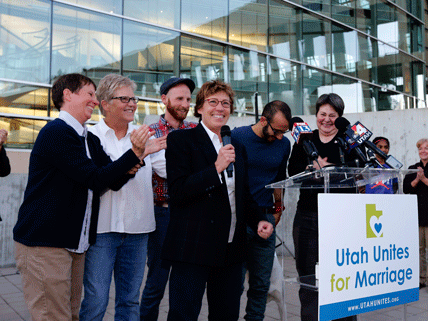Plaintiffs and their lawyer whose case was one “decided” by the Supreme Court on October 6, 2014, celebrate in Salt Lake City, Utah.
On October 6, the U.S. Supreme Court announced a “non-decision” that may end up having as profound an impact as many of its rulings. The justices decided not to review certain cases related to the constitutional status of same-sex marriage, letting stand the decisions of three federal appeals courts. These lower courts had overturned state laws that attempted to ban same-sex marriage. The surprising move was clearly a victory for advocates of same-sex marriage, and thus for gay and lesbian couples who seek to be married. Advocates of traditional marriage roundly criticized the Court’s non-decision.
The High Court did not explain its denial of certiorari (“cert” for short), which is the technical legal term for its non-decision. Yet, it may soon be looked back on as a defining moment in the controversy. In June 2013 the Court decided in Windsor v. United States to overturn the federal Defense of Marriage Act (DOMA). Since that decision, the trend of lower-court rulings has been consistently in the direction of seeing same-sex marriage as a protected constitutional right.
Five states were immediately affected by the denial of cert. Each had passed, either by popular referendum or through their elected legislatures, a law expressly defining marriage as the union of one man and one woman. These laws were then overturned on appeal by federal judges who applied the reasoning of the Windsor decision. In deciding in favor of same-sex couples who want to marry, the appeals courts asserted, in various ways, that a constitutional right to marry without state interference exists. The bans on gay marriage were held to be in violation of that right.
One day after the Supreme Court’s denial of cert, an additional federal appeals court ruled in favor of same-sex marriage. Ten days later, additional state bans were overturned, bringing the total of states across the nation that must now allow gay marriage to a clear majority—32 at last count.
Image credit: © George Frey/Getty Images
Related Links
- Supreme Court Delivers Tacit Win to Gay Marriage
This article reviews the impact of the Supreme Court’s decision clearing the way for same-sex marriage in additional states.
(Source: New York Times, October 7, 2014) - Did the Supreme Court Just Legalize Gay Marriage?
This article examines the impact of the Supreme Court’s October 6 non-decision, accurately predicting what followed.
(Source: NPR, October 6, 2014) - Courts Knock Down Gay Marriage Bans in Arizona, Alaska, Wyoming
This article updates the impact of the Supreme Court’s October 6 denial of certiorari regarding gay marriage.
(Source: Reuters, October 17, 2014) - National Organization for Marriage Condemns US Supreme Court for Not Reviewing Lower Court Rulings Imposing the Redefinition of Marriage
This press release from a leading advocacy group for traditional marriage blasts the High Court for not tackling the issue head on.
(Source: National Organization for Marriage, October 6, 2014)





Bruh.
Reginald Jones
Harvard S.O.E.
September 14, 1999
8th
This is a step in the right direction. People should be included everywhere!
People should be able to be with who they want too.
People should be with who they want to be with
The same sex marriage isnt wrong people have theyre own oppinions